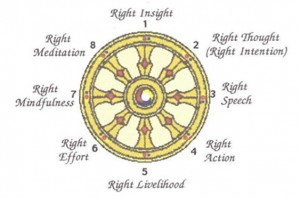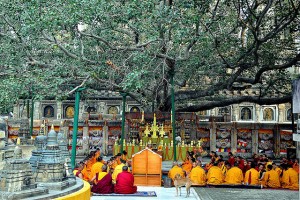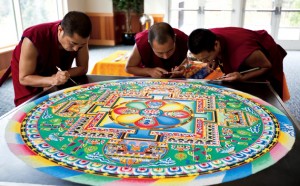Buddhism
Basic facts:
-Buddhism was founded, or started, by Siddharta Gautama around 566-487 B.C.E. (Before the Common Era, same as B.C.).
-Buddhism was a movement that rejected the caste system.
-There are approximately 376 million practitioners in the world.
3 sects of Buddhism:
-Mahayana- the Great Vehicle; dominant in East Asia-China, Japan, Korea; most common.
-Vajrayana- the Diamond/Thunderbolt Vehicle (also known as Tibetan Buddhism; this is the way the Dalai Lama follows); dominant in Tibet, Ladakh, and Bhutan.
-Theravada- the Way of the Elders (also known as Hinayana – the Little Vehicle); dominant in South East Asia and Sri Lanka.
Buddhist texts (known as the 3 baskets):
Teach three things:
-You can be in the world but not of the world
-Seize the day in youth because the body is impermanent.
-How to go about achieving enlightenment.
5 Precepts:
-not to kill
-not to steal
-not to engage in sexual misconduct
-not to utter false statements
-not to consume intoxicants
3 Marks of Existence:
-suffering (dukkha)
-impermanence (anitya)
-there is no self (anatman – no individual essence)
4 Passing Sights (and the discoveries they lead to):
-old man ->old age is inevitable
-sick man -> illness is unavoidable
-dead man -> death is the inevitable end
-an ascetic* -> it is possible to renounce worldly things and be free
*an ascetic is a person who lives separately from the world around them; they practice material and self-denial; ex) monks are groups of ascetics living together.
These are the sights that Gautama saw while walking outside the palace. These sights are what led to Gautama discovering the four Noble Truths.
4 Noble Truths:
-Life entails suffering (life inevitably involves suffering, including birth, disease, old age, and death).
-The cause of suffering is desire or threat (suffering is caused by desire and by ignorance which ultimately depend on each other – if you are ignorant of something then you cannot desire it, but once you become aware of it, you can desire it).
-Removing desire removes suffering (suffering can be ended if its causes, desire and ignorance, are removed).
-The way to remove desire is to follow the Eightfold path (the Middle Way between the extremes of asceticism and indulgence).
The Eightfold Path/Middle Way:
-Right views
-Right thought
-Right speech
-Right action
-Right livelihood
-Right effort
-Right concentration
-Right mindfulness

- Tried to end caste.
- Criticized Hindu scriptures.
- Said that caste undermines India and its culture (“Caste is anti-national…”).
- Said the answer to rejecting caste is Buddhism (and converting to it).
- “I prefer Buddhism because it gives three principles in combination, which no other religion does. Buddhism teaches prajna (understanding as against superstition and supernaturalism), karuna (love), and samata (equality). This is what man wants for a good and happy life. Neither god nor soul can save society.”
Tibetan Buddhism
-Flourished in the 11th century as religious texts started being translated.
-There is a greater focus on meditation and philosophy than there is on the Four Noble Truths.
-The Monks create madalas and bhumispara thangkas, the former to reinforce the idea of impermanence and the latter for disciples to carry with them as they travel.
-Until China invaded Tibet, the Dalai Lama (the leader of Tibetan Buddhism [and seen by other Buddhist followers as a leader]) lived there. He fled Tibet and now lives in India. “Lama” means reincarnated teacher. There is a Lama below the Dalai Lama, the Pancheon Lama. The latter is reincarnated, just as the Dalai is, but confusion surrounds the identity of the current holder of the role because the Chinese Buddhists claim to have found the reincarnation, but so did the Dalai Lama. So there are two people currently thought to be the reincarnation of the Pancheon Lama.
-The Dalai Lama preaches nonviolence: “nonviolence is a reflection of inner peace”.
Rites and Rituals:
-Meditation, mostly in the form of yoga.
-Saying mantras (certain sounds that have meaning to the disciple).
-Making mudras (symbolic hand gestures).
Holidays:
-Vesak- Celebrates the Buddha’s birthday, as well as his journey to enlightenment; it is celebrated on the first full moon day of the fourth lunar month (usually May, but in a leap year, it will be June). This is a major festival.
-Buddhist New Year- Celebrated on different days throughout the world depending on which of the three vehicles one follows.
-Sangha Day- Remembers the Buddha’s visit to Veruvana Monastery and the fact that 1,250 arhats (ones who have achieved Nirvana but not become Bodhisattvas) returned to pay the Buddha respect.
-Dhamma Day- Remembers the day of the Buddha’s first sermon -> the “turning of the wheel of Dharma”.
-Kathina Ceremony- the days on which the laity offers necessities to the Monks and Nuns (happens four times a year at the end of each season).
-Festival of Floating Bowls- Takes place after the Kathina ceremony. People place bowls made of leaves and twigs on rivers. All bad luck is supposed to be banished from the area.
-Elephant Festival- Thai Buddhists remember the Buddha’s sermon about the similarities of an elephant being tamed and a new Buddhist being taught (tamed) by an old/experienced Buddhist.
-The Festival of the Tooth- Takes place on the night of a full moon in August and honors the Buddha’s tooth that is housed in a Temple on the island of Sri Lanka.
-Ancestor Day- Last day of a fifteen day period in which spirits of the dead leave Hell and come to the physical world. People visit cemeteries and bring offerings for their departed ancestors.
(Source for holidays: http://www.religionfacts.com/buddhism/holidays.htm)
Vocabulary:
-Dharma- Buddha’s teachings -> the way things really are in the world; we are free of the world’s illusions.
-Bodh Gaya- the tree under which the Buddha achieved enlightenment.
Source: http://www.chiangraitimes.com/news/16696.html
-Buddh- to wake up (the Buddha is the ‘awoken one’).
-Samsara- cycle of birth, death, rebirth, etc.
-Nirvana- end of Samsara; there is nothing there.
-Sarnath- site of the Buddha’s first sermon.
-Bodhisattva- an enlightened follower of the Buddha who take on certain emotions or aspects of the Buddha (examples include compassion, forgiveness, tolerance, contentment, and self-discipline); they vow to return through Samsara to help other attain Nirvana; each Bodhisattva represents an element or emotion of the Buddha.
-Dalai Lama- thought to be the Bodhisattva of the Buddha’s compassion reincarnated.
-Shunya- emptiness; no-thingness; things are illusory.
-Ahimsa- the essence of dharma.
-Mandala- geometric abstraction of symbolic images that represent different parts of teachings or divine principles; created using sand; when the monks are finished creating it, they sweep it away – this represents the idea of impermanence; it usually takes weeks to create a mandala.
Source: http://www.reed.edu/reed_magazine/june2010/columns/eliot_circular/2.html
-Bhumispara Thangka- a small painting on a fabric that can be rolled up and taken anywhere; it can depict any number of important Buddhist traditions, but will most likely show either the moment the Buddha achieved enlightenment or the cycle of Samsara/the Wheel of Life.
-Tara- female Boddhisatva – she helps to protect other boddhisatvas in times of fear.


